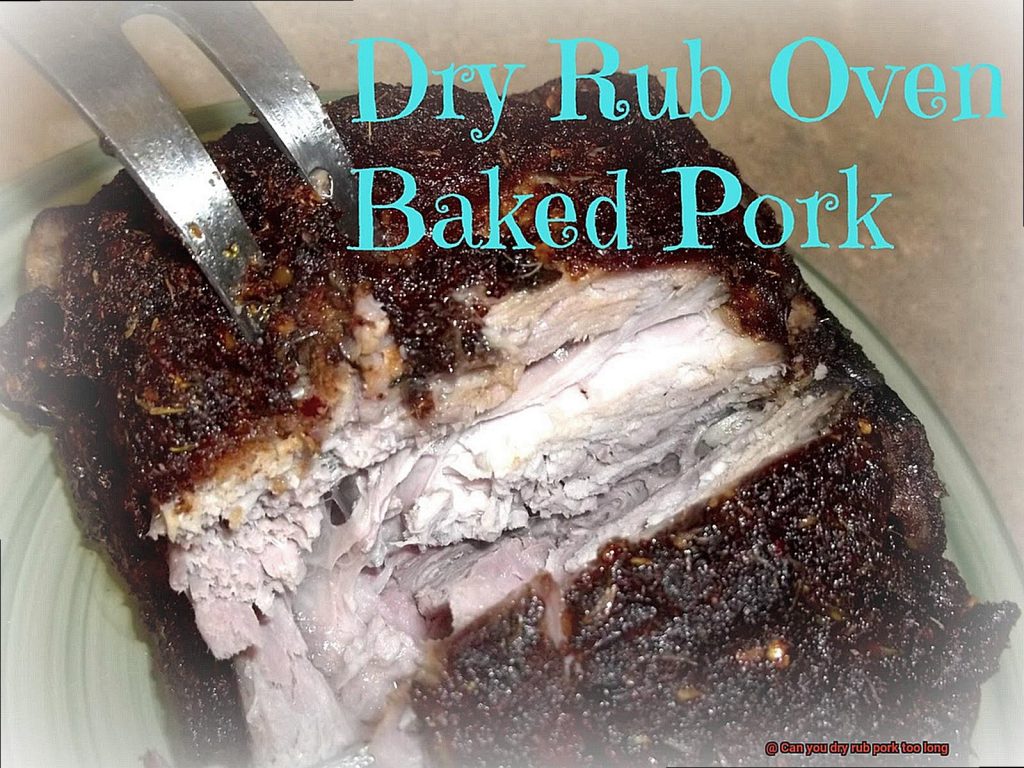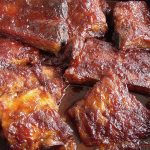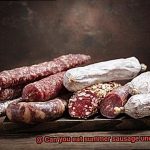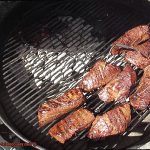Do you fancy yourself a BBQ pro, always searching for the perfect rub to elevate your pork game? The question on every pitmaster’s mind is, “Can you dry rub pork too long?” It’s a valid concern, as marinating for too long can lead to disastrous results. But fear not, my fellow meat lovers. We’re here to answer that burning question.
Dry rubbing is a popular method for smoking or slow-cooking pork. A blend of herbs, spices, and seasonings are rubbed onto the meat’s surface and left to marinate for several hours or even overnight. This process allows the flavors to penetrate the meat and create an explosion of taste in every bite.
But let’s get down to business – how long is too long? Can leaving the rub on for an extended period ruin your pork? The simple answer is no – it won’t ruin your meat. In fact, the longer you leave the rub on, the more flavorful your pork will be. However, there are some things to keep in mind when dry rubbing your pork.
Firstly, don’t worry about leaving it on too long. There’s no such thing as over-marinating when it comes to dry rubbing. Secondly, be mindful of the salt content in your rub as prolonged exposure can cause it to “cure” the meat.
In this blog post, we’ll delve into everything you need to know about dry rubbing pork and provide tips on how to avoid over-marinating your meat. So gather up your favorite recipe and let’s dive right in.
Contents
What is a Dry Rub?
A dry rub is a mixture of seasonings and spices that are rubbed onto meat before cooking, creating a crispy crust on the outside while infusing the inside with delicious flavor.
Firstly, dry rubs typically consist of a combination of salt, sugar, herbs, and spices, but the exact ingredients can vary depending on personal preference and the type of meat being cooked. For example, a spicy dry rub might include cayenne pepper or chili powder, while a sweet rub could have brown sugar or cinnamon. The possibilities are endless.
One of the advantages of using a dry rub is that it can be applied hours or even days before cooking, allowing the flavors to penetrate the meat more deeply. This is in contrast to wet marinades that contain acids that can break down the surface of the meat and make it mushy if left too long. Dry rubs also tend to be less messy than wet marinades.
When using a dry rub, it’s crucial to apply it evenly and thoroughly to all sides of the meat. A good technique is to pat the rub onto the meat with your hands or use a brush to ensure even coverage. Once the rub has been applied, wrap the meat tightly in plastic wrap or place it in an airtight container and refrigerate until ready to cook.
It’s best not to leave a dry rub on for more than 24 hours. For thinner cuts of meat or milder rubs, even less time may be necessary. Proper application and storage are key to achieving optimal flavor.
What Happens When You Leave a Dry Rub on for Too Long?
While dry rubs can enhance the flavor, texture, and color of your meat, leaving them on for too long can be a grave mistake. As a seasoned expert on this topic, let me take you on a journey to explore what happens when you commit the grilling sin of leaving a dry rub on for too long.
Firstly, dry rubs contain salt that draws out moisture from the pork. When left on for an extended period, this process can make the meat dry and tough, robbing it of its juiciness and flavor. Imagine biting into a piece of pork that feels like chewing leather – not the most appetizing experience.
Secondly, dry rubs are a blend of spices that contribute to the overall flavor profile of your dish. However, when left on for too long, the spices can become overpowering, leading to an unbalanced taste that can ruin your entire meal. Nobody wants to feel like they’re swallowing a mouthful of seasoning instead of enjoying their pork.
Lastly, leaving a dry rub on for too long can cause excessive crust formation. While some crust is desirable, too much can hinder the absorption of smoke and even cooking of the meat. A thick crust can result in burning or unevenly cooked pork that no one wants to eat.
Factors That Affect How Long You Can Leave the Rub On
The answer is yes, but don’t worry – there are several factors to consider when determining the optimal length of time to leave the rub on.
Firstly, let’s talk about the cut of pork. Thinner cuts like chops or tenderloins can absorb flavors much faster than thicker cuts like pork shoulder or ribs. As a result, it’s best to only leave the rub on thinner cuts for 2-4 hours, while thicker cuts can handle being rubbed overnight. Keep in mind that thinner cuts may dry out if left with the rub on for too long.
Another factor to consider is the type of rub. If your rub contains a high amount of salt and sugar, it may shorten the amount of time you should leave it on. Salt and sugar are natural curing agents that can break down the meat if left on for too long. However, if your rub is low in salt and sugar, you may be able to leave it on longer without any issues.
The cooking temperature also plays a crucial role in determining how long to leave the rub on. High-temperature cooking methods like grilling or broiling can cause the rub to burn and create an unpleasant taste if left on for too long. Conversely, low-temperature cooking methods like smoking or roasting allow for longer rub times as the flavors have more time to penetrate deeper into the meat.
Lastly, personal preference is key when it comes to determining how long to leave the rub on. Some people prefer a subtle flavor while others enjoy bold flavors. Experiment with leaving your rub on for different lengths of time until you find what works best for your taste buds.
Guidelines for Applying and Removing Dry Rubs from Pork
Look no further than dry rubs. These spice blends not only enhance the flavor of the meat but also give it a delightful texture. However, applying and removing dry rubs correctly is crucial to achieving the desired results. Here are some guidelines that will help you get the most out of your dry rubbed pork:
- Choose the right type of rub: The first step to a successful dry rubbed pork dish is selecting the right type of rub. Whether you’re in the mood for something sweet, spicy, or savory, make sure to pick a rub that complements the flavor of the pork.
- Apply the rub evenly: Once you’ve selected your rub, it’s essential to apply it evenly. Use your hands to massage the rub into all sides of the meat, including the fat cap. But be gentle – too much pressure or rubbing can damage the meat.
- Let it sit: After applying the dry rub, let the pork sit for at least 30 minutes before grilling. This will give the flavors time to penetrate the meat and create a delicious crust on the outside.
- Remove excess rub: Before grilling, make sure to remove any excess dry rub from the pork. You can do this by lightly brushing or shaking off any loose spices. This step ensures that your dish won’t be overly spiced or gritty.
- Don’t leave it on too long: While it’s important to let the dry rub sit on the meat for a while, don’t leave it on for too long. Leaving it on for too many hours can draw out moisture from the meat, making it tough and dry.
- Remove it after cooking: After grilling, make sure to remove any leftover dry rub from the pork before serving. This final step prevents any overpowering flavors or unpleasant textures.
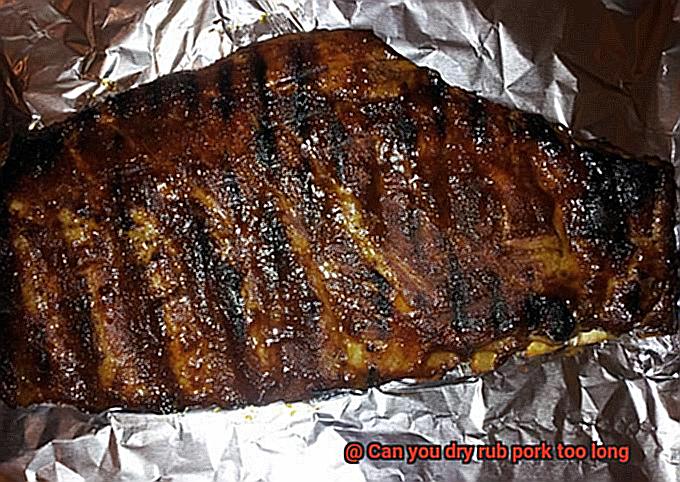
Benefits of Using a Dry Rub on Pork
When it comes to grilling pork, using a dry rub is a game-changer. Not only do these blends of herbs and spices add depth and complexity to the meat, but they also create a crispy crust and allow for precise seasoning control.
One of the biggest advantages of using a dry rub on pork is the flavor. The combination of seasonings can complement the natural taste of pork, resulting in a unique and delicious flavor profile. From smoky to spicy, sweet to tangy, there are endless possibilities for customizing a dry rub to your liking.
But it’s not just about taste. Dry rubs also help to create that coveted crispy exterior on the pork. As the rub caramelizes under heat, it forms a flavorful crust that locks in moisture and adds texture to the meat. This is essential for achieving that perfect grilled pork dish.
Another benefit? Using a dry rub allows for more control over the level of seasoning. Unlike brining or marinating, where the meat is submerged in liquid, applying a dry rub ensures even distribution of seasonings across the entire surface of the pork. This means consistent flavor throughout and eliminates the risk of over or under-seasoning.
However, it’s important to follow proper guidelines when using a dry rub. Leaving it on for too long can result in tough and dry meat, while over-seasoning can lead to overpowering flavors or unpleasant textures. So be sure to remove the dry rub at the appropriate time and follow recommended seasoning amounts.
Common Mistakes to Avoid When Applying a Dry Rub
Adding a dry rub to your meat is a game-changer. However, it’s important to apply the rub correctly to avoid common mistakes that can ruin your final product. As an expert on this topic, I’m here to share some insider tips on the common mistakes to avoid when applying a dry rub to your pork.
Firstly, let’s talk about applying too much dry rub. You want to ensure that the meat is well-coated with seasoning, but adding too much can result in an overpowering flavor and a dry exterior. Strike the perfect balance by applying just enough to enhance the flavor without overwhelming it.
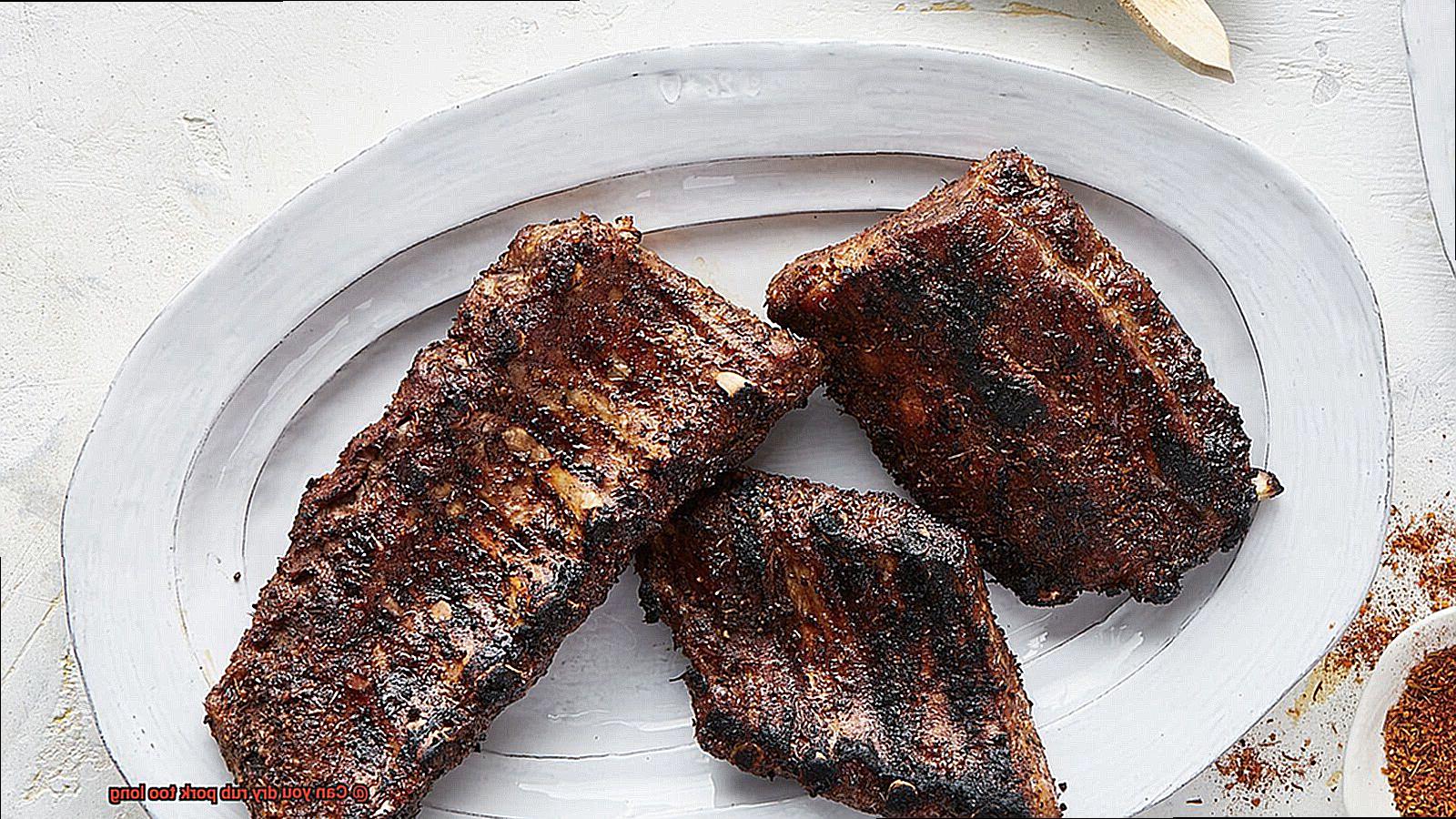
Another mistake many people make is not rubbing the meat evenly. This can lead to pockets of seasoning that are either too strong or too mild, resulting in an inconsistent flavor throughout the meat. To avoid this, take your time and ensure that the rub is evenly distributed across the entire surface of the pork.
It’s also essential to let the rub sit for at least a little while before grilling. This allows the flavors to penetrate the meat and results in a more flavorful final product. However, be careful not to let it sit for too long, as this can result in tough and unpleasant meat.
Lastly, when applying the rub, be gentle and do not rub too hard. Rubbing too hard can damage the surface of the meat and result in a tougher final product. Instead, use a light touch and allow the seasoning to work its magic.
To summarize, here are some key takeaways:
- Apply just enough dry rub to enhance flavor without overpowering
- Rub the meat evenly for consistent flavor throughout
- Let the rub sit for at least a little while before grilling
- Be gentle when applying the rub to avoid damaging the meat
Tips for Making the Perfect Dry-Rubbed Pork
Dry-rubbed pork is a popular dish that can be prepared in many different ways. However, there are some key tips to keep in mind to ensure that your dry-rubbed pork is perfect every time. In this post, we will explore five sub-sections of tips for making the perfect dry-rubbed pork.
Choose the Right Cut of Meat
Choosing the right cut of meat is essential when it comes to making the perfect dry-rubbed pork. Pork loin, pork chops, and pork shoulder are all great options for dry-rubbing because they have a good amount of fat and tenderness that make them suitable for grilling. When selecting your meat, make sure that it is fresh and of good quality.
Use the Right Combination of Spices
The spices you use in your dry rub can make or break your dish. A good dry rub should have a balance of salt, sugar, and spices to enhance the taste of the meat without overpowering it. Some popular spices for pork include paprika, garlic powder, onion powder, and cumin. Experiment with different spice combinations until you find one that you love.
Apply the Dry Rub Evenly and Monitor the Time
When applying your dry rub to the pork, it’s important to make sure that you coat all sides of the meat evenly. You can do this by either rubbing the spice mixture into the meat with your hands or using a basting brush to apply it. The ideal amount of time to leave a dry rub on pork depends on several factors, including the thickness of the meat and the strength of the flavors in the rub. As a general rule of thumb, it’s best to leave a dry rub on pork for at least 30 minutes before cooking it. However, you can also leave it on for up to 24 hours in the refrigerator for a more intense flavor.
Consider Using a Binder
Using a binder can help the spices stick to the meat better. Some common binders for dry rubs include mustard, olive oil, and honey. The binder will not only help the spices adhere to the meat but also add additional flavor.
Monitor Your Pork Closely
Finally, it’s important to monitor your pork closely when grilling it. Overcooking can lead to a dry and tough piece of meat. Use a meat thermometer to ensure that your pork is cooked to the correct internal temperature. Pork should be cooked to an internal temperature of 145°F. Remember that even after taking it off the grill, the pork will continue to cook for a few minutes, so let it rest before cutting into it.
Alternatives to Using a Dry Rub on Pork
Fear not, my pork-loving friend, as there are plenty of alternative methods to add flavor to your meat. As an expert in all things pork, allow me to share some of the best alternatives that will leave your taste buds dancing with joy.
First up, brining. This technique involves soaking the meat in a saltwater solution for several hours or overnight. Not only does this process tenderize the pork, but it also infuses it with flavor. To make it even more flavorful, you can add a variety of seasonings or herbs to the brine mixture.
Another fantastic option is marinades. You can use a combination of ingredients such as herbs, spices, and citrus juices to create a marinade that perfectly complements your pork. For maximum flavor impact, let your pork marinate for at least a few hours or even better, overnight.
Feeling adventurous? Injecting is another method that can take your pork to the next level. This involves using a needle to inject a liquid mixture directly into the meat. For larger cuts of pork like roasts or whole pigs, you can create your own injection mixture using ingredients like apple cider vinegar, Worcestershire sauce, and spices.
Last but not least, if you’re looking for a simple yet effective method, try rubbing your pork with oil and seasoning it with salt and pepper. This keeps the meat moist during cooking while still imparting delicious flavor.
Conclusion
In summary, dry rubbing pork is a surefire way to elevate the flavor profile of your meat. But can you go overboard with it? The answer is no, as there’s no such thing as too much flavor. However, there are some factors to consider when dry rubbing pork.
For starters, thinner cuts of pork will absorb flavors quicker than thicker ones. So keep an eye on the time and adjust accordingly. Also, be mindful of the salt content in your rub as it could cure the meat if left on for too long.
Another thing to note is that high-temperature cooking methods like grilling can cause the rub to burn if left on for an extended period. So make sure to monitor your meat and remove it from the heat once it’s cooked through.
To achieve optimal results when dry rubbing pork, choose the right cut of meat and use a well-balanced combination of spices. Apply the rub evenly and consider using a binder to help it stick. And if you’re feeling adventurous, experiment with different spice blends until you find one that tickles your taste buds.
Lastly, if you’re not sold on dry rubbing pork, there are other ways to infuse flavor into your meat. Brining, marinades, injecting, and oil seasoning are all viable options worth exploring.
In conclusion, while there’s no limit to how long you can dry rub pork for – just be mindful of thinner cuts and salt content – following these tips will ensure perfectly seasoned and delicious results every time.

